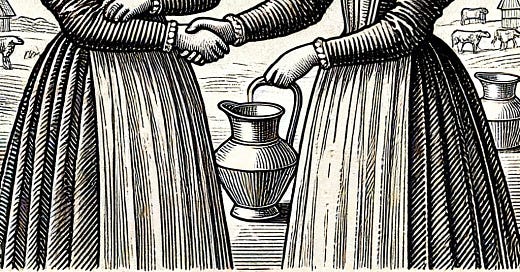How Two Dairymaids Resolved a Highland Clan Dispute
In the rugged and picturesque Highlands of Scotland, the late medieval period was a time of territorial disputes and clan rivalries. Among these skirmishes, a unique and fascinating story from the heart of Strathglass stands out—a tale of how a boundary dispute between the Chisholm clan and the Earl of Seaforth's men was resolved not by warriors, but by two humble dairymaids. This story, set in the late 16th century, offers a glimpse into the creative and peaceful conflict resolution methods of the past.
The Clans and the Dispute
The Chisholms of Strathglass and the Seaforth Mackenzies of Kintail were powerful clans, each fiercely proud of their heritage and fiercely protective of their lands. While the chiefs of these clans maintained cordial relations, their vassals often found themselves at odds over the precise boundaries of their grazing lands on the hills between Strathglass and Kintail. These disagreements would periodically flare up, threatening to disrupt the peace of the glens.
This particular boundary dispute had persisted for years, causing tension and occasional skirmishes between the two clans. The rugged terrain of the Highlands, with its rolling hills and dense forests, made it difficult to demarcate clear boundaries. Both clans relied heavily on their grazing lands for the sustenance of their livestock, making the issue all the more pressing.
In a bid to end these disputes once and for all, the chiefs decided to convene a council of wise men from both sides. The council, consisting of twenty advisors each, deliberated on various suggestions but eventually placed their trust in the wisdom and friendship of their chiefs to devise a solution. This council was a significant event, drawing on the respect and influence of the clan leaders to find a peaceful resolution.
A Creative Resolution
In a move that highlighted their leadership and wit, the chiefs of Chisholm and Seaforth came up with an ingenious plan. They proposed to send an old dairymaid from each clan to walk towards each other from their respective territories, starting from dawn. The spot where the two women met would forever mark the boundary between the Chisholm and Seaforth lands.
This agreement was accepted by all parties, and preparations were made. The chosen dairymaids, one from Comar in Strathglass and the other from Caisteal Donnan in Kintail, were sent off early the next morning. The choice of dairymaids was symbolic, representing the everyday people of the clans rather than the warriors who usually settled disputes.
The Meeting at Glen-Affaric
The two women set out on their journey, each representing the interests of their clan. The dairymaid from Kintail, undeterred by threats or obstacles, walked steadily towards Strathglass. Meanwhile, the Strathglass dairymaid, equally determined, made her way westward. The two eventually met in the western part of Glen-Affaric, on a hillock between Loch-a-bheallaich and Altbeatha.
The Kintail woman, confident in her steps, claimed that the boundary should be further into Strathglass territory. The Chisholm woman, however, was having none of it. In a dramatic and decisive moment, she struck the Kintail dairymaid with her staff, ensuring she would advance no further. The fallen woman's staff was left planted in the ground, adorned with a piece of cloth as a signal of the new boundary.
A Peaceful Conclusion
When the Chisholm men arrived at the scene, they found the staff standing as a testament to their victory. The boundary was thus established, marked by the hillock now known as Cnoc-a-chuaille, or the hillock of the bludgeon. This boundary, settled in such an unconventional manner, remained respected for generations, ensuring peace between the two clans.
The aftermath of this event was significant. The peaceful resolution of the dispute through such an unorthodox method demonstrated the wisdom and leadership of the clan chiefs. It also underscored the importance of non-violent solutions in a time when conflicts were often settled through bloodshed. This story became a part of the local folklore, passed down through generations as a lesson in conflict resolution and diplomacy.
Reflections on Tradition
The tale of the two dairymaids is more than just an entertaining story; it exemplifies the ingenuity and practicality that often characterized Highland life. It highlights the importance of trust and respect between leaders and their people, and how even the most entrenched disputes could be resolved through creative and non-violent means.
In a time when boundary disputes could easily escalate into full-blown conflicts, the resolution devised by the Chisholm and Seaforth chiefs stands as a testament to their wisdom and leadership. It reminds us that sometimes, the simplest solutions are the most effective, and that peace can be achieved through unconventional means.
The symbolic use of dairymaids, everyday members of the community, in resolving such a significant issue also speaks to the egalitarian values that could surface in Highland society. It was not just the warriors or the nobility who played crucial roles in maintaining peace and stability but also those who tended to daily chores and responsibilities.
A Legacy of Peace
As we reflect on this story from the late 16th century, we are reminded of the enduring power of tradition and the value of peaceful resolution. The legacy of the two dairymaids lives on in the history and folklore of Strathglass, a symbol of the ingenuity and resilience of the Highland clans.





